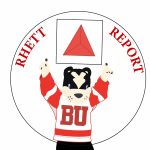With sweat pouring down her face, arms and legs, she gasps for air, recovering from a multi-mile run. Her legs are numb from the workout overload.
This is a daily occurrence for Sargent College of Health and Rehabilitation Sciences senior Jennifer Kelly, who has had one thing in mind for the last few weeks — the marathon.
Kelly will trek 26.2 miles on Monday in the Boston Marathon along with 230 other runners for Run for Research, a foundation that raises money for liver disease.
While many athletes hope to gain athletic recognition in the marathon, Kelly said her cause is almost purely charitable.
“I didn’t really know much about liver disease and how it impacts Boston and the U.S., so I decided to pick Run for Research so I can learn about it and hopefully educate people,” Kelly said, nursing her water bottle. “I also like the idea of having a team to train with.”
For the past 15 weeks, Kelly has labored through arduous cross training, weight lifting and 21-mile hikes, she said, following a 10-mile warm-up run.
That’s right — warm-up.
“The Boston Marathon is a hard course because its mostly downhill, but then you hit Heartbreak Hill, which is uphill, and that wreaks havoc on your quads,” Kelly said.
And for that reason, Kelly’s days are physical workouts: she cross trains and weight trains on Mondays and Wednesdays to increase endurance and runs 4- 11 miles four days a week.
Although Kelly ran track for two years in high school, this is her first marathon, which is part of the reason she likes the Run for Research team, which is comprised of first-time marathon runners as well as experienced athletes.
Last year Kelly participated in the New York-Boston bike ride to benefit AIDS research. And while her family could not be there to see her for that event, both her mother and sister will attend the Marathon this year.
“It’s really exciting,” Kelly said. “I was all proud of myself [last year] and I got to the finish line and I did really well, and no one was there. But it’s exciting that they will be there cheering.”
Kelly said with her extensive training this year, her goals are bolder. Qualifying for a registration number is the forefront of Kelly’s ambition, she said.
While Kelly has participated in other athletic events, most first-time runners don’t receive registration numbers, she said. Female runners in Kelly’s age group must meet a qualifying time of three hours and 40 minutes in the Boston Marathon in order to receive a number the following year. However, if runners compete through charity, they are automatically given registration numbers.
“I don’t know if I was expecting to qualify this year, but my goals have really gotten a lot higher,” Kelly said. “Now I feel like I can definitely finish under four hours. I wouldn’t have said that when I started.”
While Kelly is confident of her progress, she has hit stumbling blocks on her route. Two weeks ago she developed bicep tendonitis, a small stress fracture in her foot. In order to let the fracture heal, Kelly has been laying off running and building her endurance in the gym.
She insisted injuries will not stifle her performance.
“I’m right on the verge of the qualifying time,” she said. “But I’ll be happy as long as I finish under four hours.”
Two weeks ago, Kelly ran a 21-mile mock Boston Marathon with her training group, she said. She finished the trek in about three hours, which according to Kelly, would put her on the “verge” of the qualifying time of three hours and 40 minutes.
And she is not without outside motivation.
Ed Chiang, who graduated from the College of Engineering in December 2000, ran with Kelly during the 21-mile practice run. He said he would act as her “pacer” during the Marathon to push her to excel.
“A pacer is someone who keeps you on track for your running time,” Chiang said. “That person will help you and motivate you during the race. I’m going to try to motivate her so we can qualify her for next year.”
Kelly helped train Chiang last year when he competed in the Boston Marathon, he said. Now, he will return the favor.
And as students feast on candy, ice cream, and Dominos, Kelly has been restraining from unhealthy foods.
“Actually, while you’re running the race, you have to eat something, some form of sugar or carbohydrates. You have to be careful of hydration. So [the trainers] tell us how much we should be eating and drinking.”
Kelly, on the other hand, is a bit more idiosyncratic about her food. While her competitors eat power gel and Power Bars, she turns to Lifesavers.
“I suck on Lifesavers,” Kelly said. “After the first half of the Marathon, I have a Lifesaver every few miles. My stomach can’t handle the power gel.”
With thousands of elbows flailing and legs stomping on Monday, Kelly said she doesn’t anticipate hostility among the runners, citing a sense of camaraderie on the track.
“On the Marathon route, they have so many Marathon runners practicing on it,” Kelly said. “The running community is really great. You’ll be out there and you won’t know anyone. If you look like you are having a rough time, they will cheer you on. That’s really motivating.”
Despite her optimism, Kelly said the Marathon will be a learning experience; whether or not she qualifies for a number, she will walk away from the Marathon with experience and raised money.
“I think that I’ll be really excited that I got to be a part of the Marathon,” Kelly said. “I’ll be let down if I don’t have a good running day. I haven’t been a runner all of my life, so I don’t expect that I will be able to qualify in my first marathon.”
At the very least, she’ll be in tip-top shape.
Her mother, Emily Kelly, of Watertown, N.Y., said when her daughter was home, they both went to the gym to train.
“She’s doing good for a charity that needs the publicity and certainly the funds,” she said. “And she’s managing to keep herself in shape and have fun at the same time. I think that is marvelous.”
This is an account occasionally used by the Daily Free Press editors to post archived posts from previous iterations of the site or otherwise for special circumstance publications. See authorship info on the byline at the top of the page.



